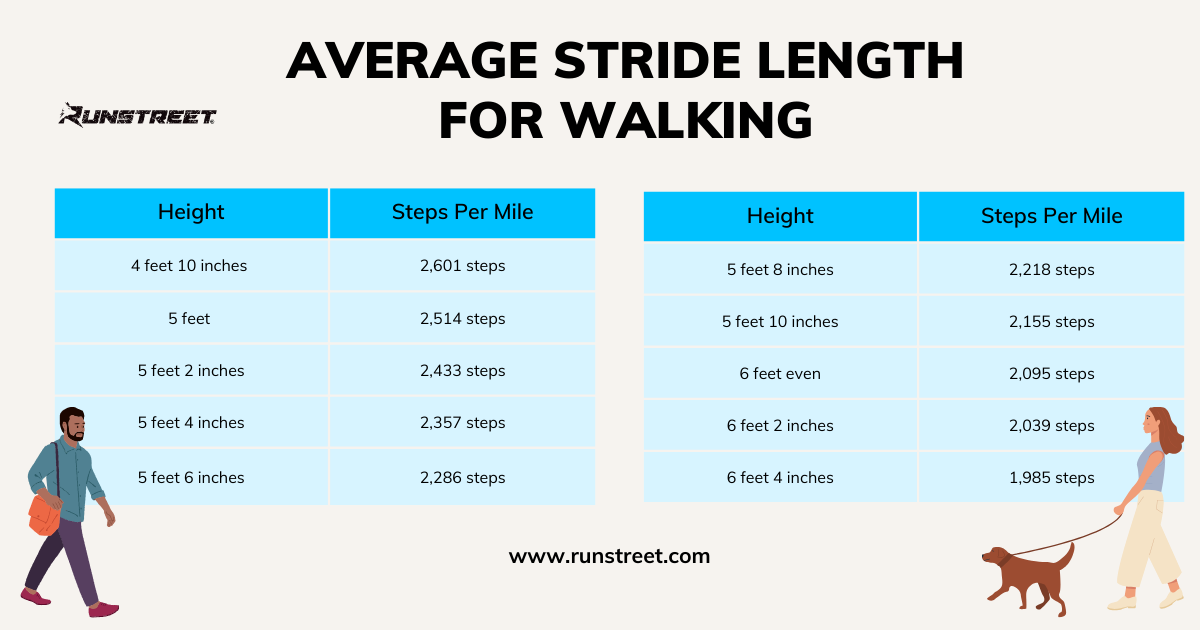How Many Steps in a Mile? Charts for Walking & Running
Photos by Marques Jackson Photography.
By Marnie Kunz,
Certified trainer and run coach
Are you wondering how many steps in a mile when you walk or run? Whatever your pace, understanding your step count can help you track fitness goals and improve performance. This guide breaks down average steps per mile by pace and height. As a trainer and running coach, I am often calculating step counts and using step counts to give people daily activity guidelines. Most people generally take between 2,000 and 2,500 steps when walking a mile. Runners take longer strides than walkers, usually taking between 1,000 and 2,000 steps in a mile. But your exact step count depends on a few factors, including your stride length and pace.
Related Post: The Ideal Daily Step Count for Every Age Group
Steps in a Mile Based on Stride Length
Average stride length for different heights.
Stride length is one of the biggest influences on your amount of steps in a mile. Generally, taller people take longer strides and have fewer steps per mile. Here is a chart with an estimate of average stride length based on height, according to researchers:
Pace
Your pace is the other variable that affects your number of steps in a mile. In general, when you walk or go at a slower pace, you will have more steps per mile than if you run or move at a faster rate. So you'll get in more walking steps in a mile than you would running. When you increase your pace, you take longer strides, which gives you fewer steps per mile.
Similarly, your walking speed also influences your total daily steps. If you have a faster walking pace, you will have less steps per mile. The average person walks at around a 20-minute-mile pace. Fitness walkers, however, (or New Yorkers!), often walk faster, making them have a longer average step length and less steps per mile.
This chart assumes an average adult stride of about 2.1 to 2.5 feet when walking and 3 to 4 feet when running.
Running Vs. Walking Steps in a Mile
According to one study, these are the average steps in a mile for different speeds of walking and running:
Walking at a pace of 20 minutes per mile (or 3 miles per hour): 2,252 steps per mile
Brisk walking at a pace of 15 minutes per mile (or 4 miles per hour): 1,935 steps per mile
Running at a pace of 12 minutes per mile (5 miles per hour): 1,951 steps per mile
Running at 10 minutes per mile pace (6 miles per hour): 1,672 steps per mile
Running quickly, at 8 minutes per mile pace (7.5 miles per hour): 1,400 steps per mile
Related: What Trainers Say About The Viral Japanese Walking Workout
As with walking, your running speed also influences your steps per mile. If you run faster such as during a speed workout, you will generally have less steps. Your running speed can depend on your fitness level and training goals.
Terrain
The surface you are walking or running on also affects the number of steps you take in a mile. Uneven terrain can shorten your strides, whereas flat, paved surfaces may lengthen your stride. If you’re hiking, you are more likely to take more steps per mile than if you're walking on city streets.
These different surfaces can change your stride rate and step count per mile:
Uneven terrain: Uneven terrain, such as hills or trails, requires you to take shorter steps to maintain your balance. This can increase the number of steps you take per mile.
Soft terrain: Soft terrain like sand or snow can also require shorter steps. This is because your foot sinks into the ground, which reduces your stride length.
Incline: Walking uphill requires you to take more steps per mile than walking on flat ground. This is because you must lift your legs higher to clear the ground.
Decline: Walking downhill requires fewer steps per mile than walking on flat ground. This is because gravity pulls you down the hill, which helps you cover more ground with each step. You will take fewer steps per mile when walking down hills.
As far as calorie burning goes, if you’re walking for weight loss, hiking burns more calories than walking on paved trails. Of course, all forms of walking are excellent for cardiovascular and health benefits.
Related Post: I Tried 10,000 Steps a Day for a Month: Here’s What Happened
Tracking Your Steps
There are different ways to measure your steps per mile and daily step count.
Manually count your steps. One way is to manually measure your steps. You can then use a calculator to make calculations on your average steps per day. To do this, you can go to an outdoor track that is standard length (400 meters, almost a fourth of a mile). Walk around the inside lane for one lap and count your steps. Multiply this number by 4 to get an estimate of your steps per mile.
Use a tracking app such as a pedometer app or a fitness tracking app like Google Fit or Apple Health. Tracking apps use GPS signals to determine your location and movement and can give you a general idea of your steps in a mile and steps per day.
Use a fitness tracking device such as a Garmin watch, Fitbit, or Apple Watch to track your steps. Fitness trackers can vary in accuracy, and some determine your step count based on the amount you move your arms, so it can be inaccurate when you’re on a treadmill holding the rails or pushing a baby stroller. Measure your step count for a mile with your tracker, and make sure your tracker reads 1 mile so you know it’s synced right.
Related Post: 15 Best Running Apps That Are Free
Setting Step Goals
Setting a daily step goal can help you improve your fitness and stay healthy. There are many benefits of walking, from improved mental health to better heart health and reduced risk of common diseases like heart disease and diabetes. Here are some tips to help you add more walking to your daily routine:
Make small changes in your lifestyle to walk more.Takethe stairs instead of the elevator, walk to do some of your errands, or take your dog on an extra walk each day. From my experience as a personal trainer, making small changes to your daily habits can give you lasting long-term rewards.
Walk with others. Whether it’s your family, friend, or co-workers, going for a walk with people (or your pets!) makes exercise more fun. It’s an accessible way to improve fitness that most people can join in.
Take the scenic route. Make walking more fun by going on adventures. You can explore your local botanical gardens, go for a hike, or walk to a museum you love. There are endless possibilities when it comes to inspiring destinations.
Set a daily step goal. Having a goal will help you stay motivated and accountable. It will also build yoru confidence to see your progress.
Related Post: 10 Morning Walk Health Benefits + Tips to Get Started
Frequently Asked Questions
Q: How many steps are in a mile?
A: On average, walking a mile takes 2,000–2,500 steps, while running a mile takes about 1,400–2,000 steps depending on your speed and stride length.Q: How many miles is 10,000 steps?
A: The distance for 10,000 steps can vary based on your stride length and pace. For most people, 10,000 steps equal 4 to 5 miles of walking or 5 to 10 miles of running.
Q: How do you calculate step count?
A: You can use a step-tracking app, fitness tracker watch, or device or manually count your steps for a measured distance.
Q: What affects the number of steps in a mile?
A: Your stride length, pace, and height all affect how many steps you take in a mile.Q: How many steps make 1 mile?
A: Your exact number of steps in a mile depends on your height, stride length, and the speed at which you move. Most people generally take 2,000 to 2,500 steps to walk a mile and 1,000 to 2,000 steps to run a mile.
Q: Does 5,000 steps equal 1 mile?
A: For most people, 5,000 steps equals more than a mile of walking or running. Walkers usually take 2,000 to 2,500 steps per mile, meaning they walk 2 miles or more in 5,000 steps. Runners usually hit 1,000 to 2,000 steps per mile, so they would run 2.5 to 5 miles to hit 5,000 steps.
Q: How many steps should I take per day?
A: The number of steps you should take daily for optimal health depends on your age and health. According to researchers, adults aged 59 and younger can benefit the most from 8,000 to 10,000 steps per day, and adults aged 60 and older benefit the most from taking 6,000 to 8,000 steps daily.
How many steps do you take per day? Share your walking and running progress by tagging @Runstreet on Instagram to get cheered on. If you need a training plan to crush your fitness goals, head to our Training Center. Happy stepping to you! 😊
Related Posts: Recommended Steps Per Day by Age: A Complete Guide, I Tried 10,000 Steps Per Day for a Month, How to Do a Steps Challenge
Marnie Kunz is a NASM-certified trainer and USATF- and RRCA-certified running coach, a dog lover, an Akita mom, and the founder of Runstreet. She is based in Brooklyn, New York.





